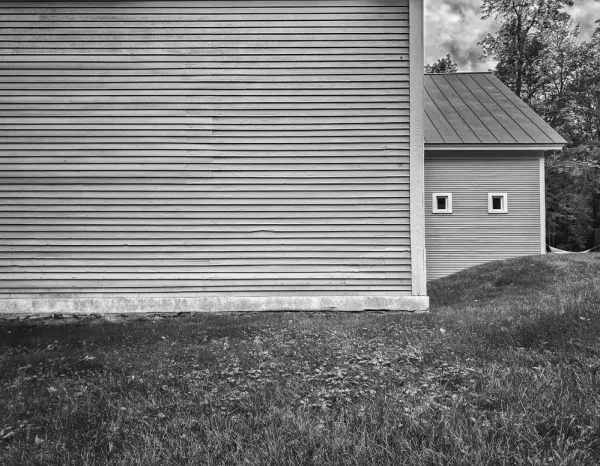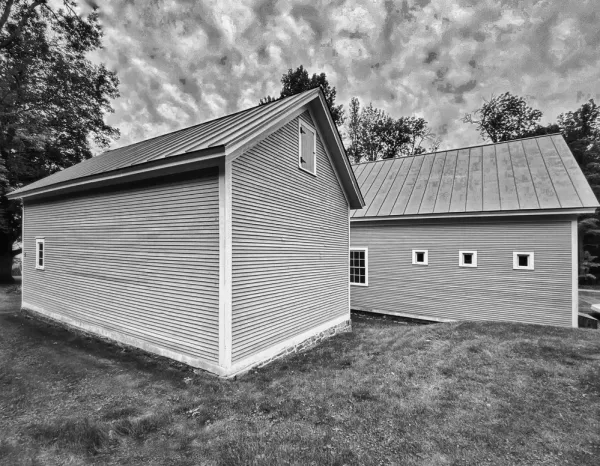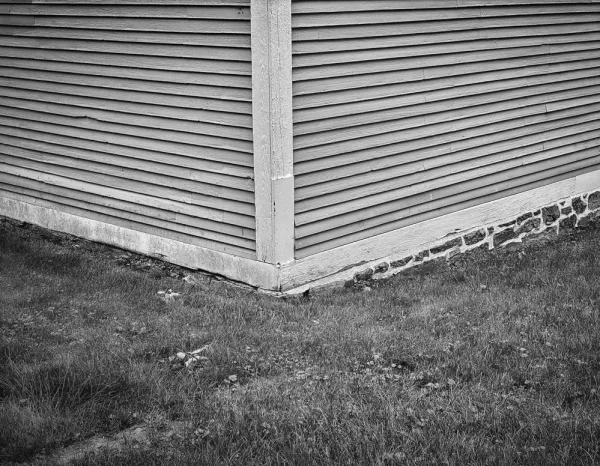The past lives on in art and memory, but it is not static: it shifts and changes as the present throws its shadow backwards. — Margaret Drabble
I return today to a recurring theme, a preoccupation perhaps, that wends its way through my Rosslyn ruminations and my collections of photographs and artifacts. While the past lives on, the present riffs, repurposes, and reimagines the past. Adaptive reuse. Upcycling. Reinvention. Art.
Buckle up. Or pour yourself a cocktail…

NW Corner of Icehouse
Before tripping too far into the wilds of my imagination, let’s root the present inquiry in something a little less abstract, a little more concrete. Like, for example, the northwest corner of the icehouse about a year and a half ago, September 21, 2021. That’s what you see in the photo above as well as those below.
I’ve titled this post, “The Past Lives On”, and if you’ve been with me for any time at all you’re well aware that Rosslyn, the property around which this multimodal inquiry circumnavigates like a drunken sailor, is rooted in the past. And the present. Starting out in the early 1800’s and spanning almost exactly two centuries.
I’ve pilfered the title from the quotation above, ostensibly the perspective of Virginia Woolf filtered through the mind of Margaret Drabble. The broader context for Drabble’s perspective is landscape. Let’s look a little further.
The past lives on in art and memory, but it is not static: it shifts and changes as the present throws its shadow backwards. The landscape also changes, but far more slowly; it is a living link between what we were and what we have become. This is one of the reasons why we feel such a profound and apparently disproportionate anguish when a loved landscape is altered out of recognition; we lose not only a place, but ourselves, a continuity between the shifting phases of our life. — Margaret Drabble, A Writer’s Britain: Landscape in Literature, Thames & Hudson, 1987 (Source: Ken Taylor, “Landscape: Memory and Identity”)
In the photo above I’ve recorded the exterior of the icehouse and adjoining lawn as it has looked since approximately the 1950s which is when we understand that a clay tennis court was built behind the icehouse and carriage barn for the pleasure of Sherwood Inn guests.
Actually, I’m slightly oversimplifying the contours of history. Given what I understand, the clay court was installed for Sherwood Inn patrons, but at some point in the decades since, the court was abandoned. Or at least *mostly* abandoned. The +/-10′ tall wooden posts for an enclosure along the northern end of the court remained until we removed them early in our rehabilitation. And one of the two steel tennis net posts will at long last be removed in about a week when Bob Kaleita returns to tune up the site for hardscaping and landscaping. But a long time ago the clay surface was abandoned and a perfectly flat lawn replaced it. We’ve enjoyed using it as a croquet, bocce, and volleyball court for years.
If you look at the bottom right of the photograph at the top of this post you can see that there’s a topographical bulge in the lawn, sort of a grassy hummock that is crowding the building(s). In the photo below you can again see how the ground is higher than the framing on both buildings.

Not an ideal situation when organics (lawn, landscaping, etc.) crowd wooden buildings. Unfortunately the tennis court was built above the sills of both buildings, and inauspiciously close. Moisture, snow, and ice buid-up over the decades compromised the structures of both buildings because of this miscalculation.
Today, both buildings have had their framing rehabilitated, and their structural integrity is better than ever. In addition, significant site work last autumn (remember “The art of Dirt Work“?) and again next week is restoring the ground level adjacent to the icehouse and carriage barn to more closely resemble what it likely looked like in the 1800s when both buildings were originally sited and constructed.
A landscape altered. A landscape restored.
A memory recreated with the art of landscaping. The past made present. And yet, not. The new grade has been reimagined as an outdoor recreation and entertaining area not likely resembling the environs a couple hundred years ago. And so it is that the past “shifts and changes as the present throws its shadow backwards”…

Present Shadowed Past
What if innocence,
in a sense, is less
unbiased naïveté
than wonder-wander,
curiosity,
and experiment?
Or kneading gray clay
dug behind the barn,
behind the garden,
before the forest
(but barely before)
after summer rain
forty years ago.
Stiff and cold at first,
loosening with touch,
oozing through cupped palms
and playful fingers,
shapes suggest themselves.
Contours and textures
echo yesterdays
unrecorded and
likely forgotten
but re-emergent,
confections conjured
of sodded clay, and
curiosity.
The Past Lives On
Indeed, something endures, but rarely should we be confident that we know the past as it was. As it once was. We are informed, and perhaps sometimes misinformed, by our perspective sometime subsequent to the archival echo upon which we fixate. And yet, perhaps allowing for reimagination, adaptive reuse, and even ahistoric reinvention, drawing upon the artifacts and memories we inherit but investing them with whimsy and wonder is one of the best ways to rehabilitate the past. Art from artifacts…
Leave a Reply